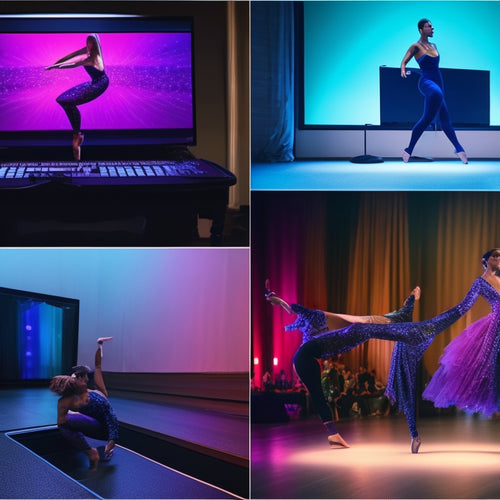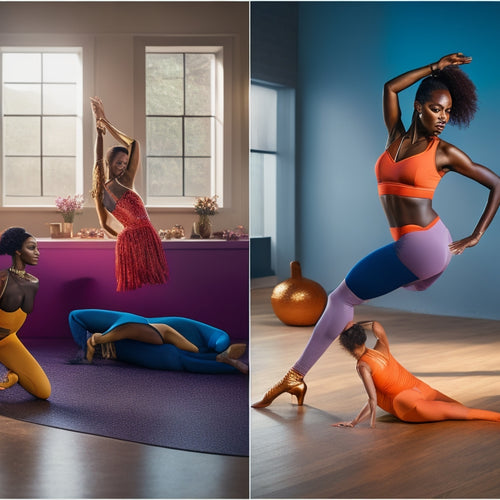
Best High-Quality Dance Shoes for Professional Dancers
Share
When choosing high-quality dance shoes, prioritize sole materials like suede for ballroom dancing or rubber for hip-hop styles, as they impact grip and movement. Look for comfortable features, including cushioned insoles and adequate arch support, to prevent fatigue during long practices. Breathable materials help control temperature and moisture, enhancing your overall comfort. Durability is vital too—invest in shoes with reinforced seams and quality materials that hold up under intensive use. By understanding the intricacies of each dance style, you can select the perfect footwear that supports your artistry. There's still more to investigate on shoe selection and performance enhancement.
What You Need to Know
- Choose shoes with suede soles for ballroom dancing to enhance fluid movement and controlled turns, while rubber soles are better for street styles.
- Look for cushioned insoles and arch support to reduce fatigue and prevent injuries during extended practice sessions.
- Opt for breathable materials to maintain temperature control and moisture-wicking properties, ensuring comfort during long rehearsals.
- Consider specialized shoes based on dance style, such as ballet slippers for flexibility or jazz shoes for quick footwork.
- Invest in durable materials with reinforced seams to ensure longevity and performance under the demands of professional dancing.
Superior Grip on Dance Floors
When selecting dance shoes, the sole material plays an important role in providing the superior grip you need on various dance floors.
Features like sole thickness and tread patterns can greatly enhance your performance, allowing for both smooth turns and secure stops. Understanding how these elements work together will guarantee you maximize your control and safety while dancing.
Proper fit is also vital for peak performance, as a snug fit enhances flexibility and freedom of movement, making it essential to consult with expert fitters for advice on selecting the right shoes.
Essential Sole Materials
Although various dance styles require different footwear, the choice of sole material is fundamental for achieving superior grip on dance floors. When selecting dance shoes, consider materials like suede, leather, and rubber, each offering unique benefits.
Suede provides excellent traction while allowing for the necessary sole flexibility, enabling you to execute fluid movements without sacrificing control. Leather, on the other hand, offers durability and a classic feel, though it may require a break-in period to achieve ideal grip.
Rubber soles can provide superior traction on certain surfaces, but they're typically heavier and may limit your ability to pivot smoothly. It's essential to balance grip with the freedom of movement, ensuring that your shoes enhance your performance rather than hinder it.
Additionally, arch support plays an important role in maintaining proper alignment and comfort, allowing you to dance longer without fatigue.
Ultimately, choosing the right sole material contributes not just to grip but also to your overall experience on the dance floor. Pay attention to how each material interacts with your movements, and select shoes that enable you to express your artistry fully.
Tread Patterns Explained
Selecting the right sole material is just the beginning; tread patterns play a significant role in maximizing grip on dance floors. The tread design of your dance shoes directly influences your traction performance, allowing you to execute moves with precision and confidence. A well-thought-out tread pattern can make the difference between slipping during a turn or smoothly shifting into your next step.
Different dance styles require specific tread designs customized to their unique demands. For example, ballroom dancers benefit from a suede sole that facilitates controlled slides while providing enough grip to anchor turns. In contrast, street dancers may prefer a rubber sole with a multi-directional tread pattern that offers superior grip on various surfaces.
When evaluating tread patterns, consider factors such as depth, shape, and material. Deeper grooves enhance grip but may restrict fluidity in certain styles. Conversely, shallower patterns allow for smoother movement but might compromise stability.
Ultimately, understanding how tread design affects traction performance will enable you to choose the right pair of dance shoes, giving you the freedom to express yourself fully on the dance floor.
Enhanced Comfort for Long Practices
When you're practicing for hours, cushioned insoles become essential for reducing fatigue and providing support.
The soft texture enhances comfort, allowing you to dance longer without discomfort.
Additionally, breathable materials play a critical role in maintaining comfort by allowing air circulation, preventing overheating and moisture buildup.
Choosing the right combination guarantees you can focus on your performance without distraction.
Cushioned Insoles Necessity
Balancing on your toes and executing intricate routines can take a toll on your feet, making cushioned insoles a requirement for professional dancers. These insoles provide the crucial support and comfort you need during long practices, reducing fatigue and enhancing your performance. When you choose dance shoes with cushioned insoles, you're prioritizing foot health considerations that can greatly influence your longevity in the profession.
The arch support significance cannot be overstated. Proper cushioning helps distribute weight evenly, alleviating pressure on the arch and preventing injuries. It enables you to focus on your artistry without the distraction of discomfort.
| Feature | Benefit |
|---|---|
| Shock Absorption | Reduces impact stress |
| Enhanced Arch Support | Maintains foot alignment |
| Moisture-Wicking | Keeps feet dry and cool |
| Lightweight Design | Promotes agility and speed |
| Durable Materials | Guarantees longevity and reliability |
Incorporating cushioned insoles into your dance shoes is more than just a comfort upgrade; it's a crucial decision for your overall foot health. Enjoy the freedom to dance without limits while safeguarding your feet for years to come.
Breathable Materials Importance
Comfort is vital for any professional dancer, and breathable materials play an important part in achieving that during long practices. When you're dancing for hours, your feet can quickly heat up, leading to discomfort and distraction. This is where the breathability benefits of advanced materials come into play. They allow air to circulate around your feet, keeping them cool and dry.
Breathable dance shoes often feature mesh panels or moisture-wicking fabrics that enhance temperature control. By regulating the heat and moisture buildup, these materials help prevent excessive sweating and the potential for blisters. You'll feel more at ease, allowing you to focus on your technique and performance rather than on any discomfort caused by overheating.
Moreover, breathable materials contribute to an overall lightweight feel, giving you the freedom to move as you wish. They support extended practice sessions without the usual fatigue that comes from damp, heavy footwear.
Choosing dance shoes made from breathable materials means investing in your comfort and performance, ensuring you can dance longer and with greater confidence. So, prioritize breathability in your dance footwear selection, and experience the difference it makes.
Innovative Breathable Materials
When you're dancing for hours, the materials in your shoes can greatly impact your performance.
Lightweight fabric technologies guarantee that your shoes offer both agility and support, while advanced moisture-wicking features keep your feet dry and comfortable.
Choosing dance shoes made from breathable fabrics enhances your overall experience on the floor, as they help regulate temperature and wick away sweat.
Lightweight Fabric Technologies
In the domain of professional dance, lightweight fabric technologies have revolutionized the way dancers experience movement and performance. These innovative materials provide unmatched performance enhancement through their unique blend of fabric flexibility and breathability.
By using advanced synthetic fibers, manufacturers have created dance shoes that allow for a natural range of motion, ensuring that you can execute every pirouette and leap with ease.
When you wear shoes crafted from these lightweight fabrics, you'll immediately notice how they conform to your foot without sacrificing support. The reduced weight means you can focus on your technique, rather than feeling burdened by heavy footwear.
The flexibility of these materials allows for seamless shifts, whether you're performing intricate choreography or improvising on stage.
Moreover, the integration of high-tech fabrics minimizes bulk, freeing you to move with a sense of liberation. You'll find that these shoes adapt to your body's movements, creating a second-skin feel.
In this way, lightweight fabric technologies not only enhance your performance but also uplift your overall dancing experience, allowing you to express your artistry fully and authentically.
Moisture-Wicking Features
Moisture-wicking features in dance shoes play an essential role in maintaining performance and comfort during intense routines. As a dancer, you know that sweat absorption can hinder your ability to execute movements fluidly. Innovative breathable materials are designed to enhance moisture management, allowing you to focus solely on your artistry.
These advanced fabrics draw moisture away from your skin, reducing the feeling of dampness and discomfort. This technology not only helps keep your feet dry but also minimizes the risk of blisters and irritation, which can sidetrack your performance. When you choose dance shoes with proper moisture-wicking capabilities, you're investing in both your health and your craft.
Look for shoes made with synthetic fibers or mesh panels that promote airflow. These materials allow sweat to evaporate quickly while providing support and flexibility. Additionally, some designs incorporate antimicrobial properties to combat odor, ensuring you feel fresh even after a long rehearsal.
Ultimately, selecting dance shoes with effective moisture-wicking features enables you to dance freely, without the distraction of wet feet. Prioritize this essential aspect, and uplift your performance to new heights.
Selecting Based on Dance Style
When choosing dance shoes, it's essential to take into account the specific demands of your dance style.
For ballet, you'll need shoes that offer both flexibility and support, allowing for precise movements and balance.
In contrast, jazz and hip-hop require footwear that enhances agility and grip, accommodating quick footwork and energetic shifts.
Additionally, dancers with wide feet may face challenges in finding suitable options that provide comfort and performance; checking for wide-width models can help alleviate discomfort during practice and performances.
Ballet Shoe Considerations
Selecting the right ballet shoes is vital for any dancer aiming to excel in their craft, as the choice directly influences performance and technique. Start by considering the various ballet shoe types available, such as soft ballet slippers, pointe shoes, and demi-pointe shoes. Each type serves a unique purpose and supports different levels of training and performance.
When selecting your ballet shoes, pay close attention to the fit. A well-fitted shoe should hug your foot snugly without being overly tight. It's important that your toes can move slightly while still being supported.
A properly fitted ballet shoe enhances your connection to the floor, allowing for greater freedom in movement and precision in technique.
If you're moving to pointe work, verify that your pointe shoes offer the right balance between support and flexibility. Consult with your instructor or a professional fitter to determine the best shoe for your foot shape and level.
Jazz and Hip-Hop Choices
Choosing the right shoes for jazz and hip-hop styles is vital, as different movements and techniques demand specific footwear features.
For jazz, you'll want to focus on jazz shoe styles that offer flexibility, allowing for quick footwork and turns. Look for shoes made from soft leather or canvas, with a split sole that enhances your ability to articulate your foot. These features support your movement while providing the necessary grip for various dance floors.
When it comes to hip-hop, comfort and durability are key. You should consider popular hip hop brands like Nike or Adidas, as they design shoes specifically for street dance. Confirm the shoes have a sturdy sole with good cushioning to absorb impact during jumps and hard landings.
High-tops can be a fantastic choice for additional ankle support, which is essential for the lively movements characteristic of hip-hop.
Ultimately, selecting the right footwear is about enhancing your performance and allowing for freedom of expression. Pay attention to fit and functionality, and you'll find the perfect jazz or hip-hop shoe that complements your style and technique beautifully.
Durability for Intensive Use
When selecting dance shoes, the quality of materials directly impacts their longevity, especially under intensive use.
You need shoes that not only withstand repetitive movements but also provide the necessary support and flexibility for your performance style.
For instance, elegant ladies Latin shoes made with lightweight materials and a cushioned insole can enhance comfort during long practice sessions.
Understanding the specific materials used in construction can help you make an informed choice that aligns with your rigorous training demands.
Material Quality and Longevity
Over time, the material quality of dance shoes directly impacts their durability and performance, especially for professional dancers who put their footwear through intensive use.
When choosing your shoes, consider the differences between leather and synthetic materials. Leather offers natural breathability and molds to your feet over time, providing a custom fit. However, it may require more care and can be less resistant to moisture.
On the other hand, synthetic materials often boast improved durability and resistance to wear, making them ideal for rigorous routines.
Pay attention to the stitching techniques as well; high-quality shoes will feature reinforced seams that withstand the stress of energetic movements. Look for double or triple stitching, which greatly improves the longevity of the shoe.
Additionally, consider how the material interacts with your dance style. For instance, a shoe meant for ballet might prioritize flexibility, while a jazz shoe could emphasize sturdiness.
Ultimately, investing in high-quality materials not only elevates your performance but also guarantees your shoes can endure the rigors of daily practice and performance, allowing you to dance freely without the worry of wear and tear.
Frequently Asked Questions
How Do I Determine My Correct Dance Shoe Size?
To determine your correct dance shoe size, consult a sizing chart and measure your foot accurately. Remember, dance shoe fitting varies by brand, so always try on different styles to find your perfect fit.
Can I Wear My Dance Shoes Outside?
Can you really risk damaging your dance shoes outside? Outdoor performance risks and shoe material durability often clash, so stick to designated surfaces to preserve your footwear and maintain peak performance during your routines.
How Often Should I Replace My Dance Shoes?
You should replace your dance shoes every 6-12 months, depending on usage. Watch for signs of wear, such as reduced support or damaged soles, as these indicate your dance shoe lifespan is nearing its end.
Are Custom Dance Shoes Worth the Investment?
Custom dance shoes are worth the investment for you. They offer custom shoe benefits like a personalized fit, enhancing comfort and performance. Customized footwear can reduce injury risk and boost your freedom of movement on stage.
How Can I Maintain My Dance Shoes for Longevity?
Your dance shoes are like a trusted partner; nurture them with shoe cleaning after each use, and protect the soles from wear. Regular care guarantees they support your movements, allowing you to truly express your artistry.
Explore More
In choosing the right dance shoes, remember that over 70% of professional dancers report that comfort greatly affects their performance. With superior grip, enhanced comfort, and breathable materials customized to your dance style, you can guarantee your shoes support you through every long practice and performance. Investing in high-quality footwear not only enhances your confidence but also extends the lifespan of your shoes, making them an essential element in your dance experience. Don't underestimate their importance!
Related Posts
-

Elevate Your Dance Choreography With Top Video Editing Tools
You're just a few clicks away from maximizing your dance choreography potential! With top video editing tools like Ad...
-

Dance Wear Must-Haves for Elevated Performance
To raise your dance performance, prioritize wear that offers superior breathability and comfort. Look for moisture-wi...
-

Frozen Frenzy: Creative Crafts Galore
We're entering a winter wonderland of creativity, where snowflakes sparkle, ice castles shine, and magic unfolds in e...


